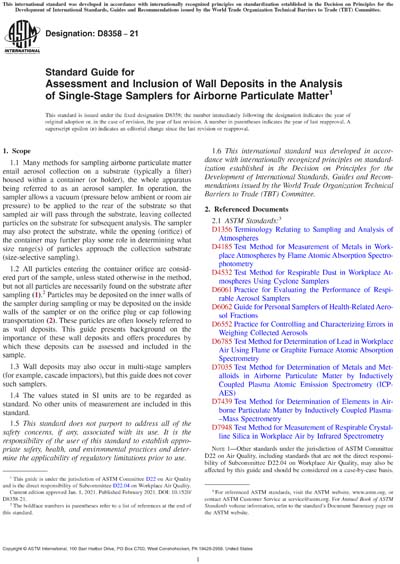Most recent
ASTM D8358-21
Standard Guide for Assessment and Inclusion of Wall Deposits in the Analysis of Single-Stage Samplers for Airborne Particulate Matter
1.1 Many methods for sampling airborne particulate matter entail aerosol collection on a substrate (typically a filter) housed within a container (or holder), the whole apparatus being referred to as an aerosol sampler. In operation, the sampler allows a vacuum (pressure below ambient or room air pressure) to be applied to the rear of the substrate so that sampled air will pass through the substrate, leaving collected particles on the substrate for subsequent analysis. The sampler may also protect the substrate, while the opening (orifice) of the container may further play some role in determining what size range(s) of particles approach the collection substrate (size-selective sampling).
1.2 All particles entering the container orifice are considered part of the sample, unless stated otherwise in the method, but not all particles are necessarily found on the substrate after sampling (1).2 Particles may be deposited on the inner walls of the sampler during sampling or may be deposited on the inside walls of the sampler or on the orifice plug or cap following transportation (2). These particles are often loosely referred to as wall deposits. This guide presents background on the importance of these wall deposits and offers procedures by which these deposits can be assessed and included in the sample.
1.3 Wall deposits may also occur in multi-stage samplers (for example, cascade impactors), but this guide does not cover such samplers.
1.4 The values stated in SI units are to be regarded as standard. No other units of measurement are included in this standard.
1.5 This standard does not purport to address all of the safety concerns, if any, associated with its use. It is the responsibility of the user of this standard to establish appropriate safety, health, and environmental practices and determine the applicability of regulatory limitations prior to use.
1.6 This international standard was developed in accordance with internationally recognized principles on standardization established in the Decision on Principles for the Development of International Standards, Guides and Recommendations issued by the World Trade Organization Technical Barriers to Trade (TBT) Committee.
Content Provider
ASTM International [astm]






